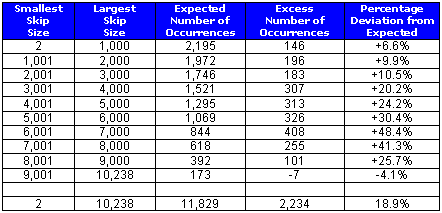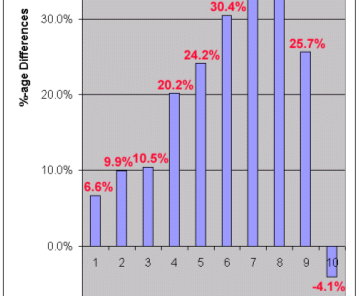This is the latest installment on exploring and analyzing the phenomena. As I recall, nothing even close to a mosaic has EVER been found in ANY other Hebrew text--that is--nothing that has the same sort of appearance of something theologically sound and supernaturally coded. To my layman’s mind, some of them have been beautiful and awesome in their simplicity and in their faithfulness to Biblical theology—especially regarding Christ’s deity etc. Yet, it’s been troublesome and frustrating not to be able to assess them scientifically compared to chance.
I realize it’s not fashionable for seemingly most naysayers to actually read the quality research in support of the codes. But I hope that even skeptics will look at the mosaic type of codes fair-mindedly and closely. In any case—here’s this section of the latest Digest]
Bible Code Digest January/February 2005
The Controversy Over Mosaics: Round Five
Given a Hebrew word, a search text and a range of skip sizes, leading code software will instantly tell you how many times ELSs of that word will appear—by chance. What are we to make of instances where there is a large difference between the expected number of occurrences and the number of times the given ELS actually appears? And what if large differences occur for many different skip size ranges? When that happens, we call it a "mosaic."
Now, we aren't talking about an ELS that is only expected to appear one or two times in the search text. We're talking about ELSs that are expected to appear 50 or 500 or 5,000 times—because the ELS only consists of a few letters.
Let's look at an interesting example. Take the Hebrew word Eckad (alef-khet-dalet), which means "one." It is undoubtedly one of the most significant words in the Jewish faith. It appears at the end of the Shema of Deuteronomy 6:4 ("Shema Yisrael! Adonai Elohenu Adonai Eckad" or "Hear O Israel! The Lord is our God, the Lord is one.").
This places it at the heart of Judaism and its belief in a single, living God. Within the first 17 chapters of Genesis, the three-letter-long Eckad ELS consistently appears much more often than expected by chance over all but one range of skip sizes, as shown in the following table.

For example, the Eckad ELS appears 1,252 times with skips between 6,001 and 7,000 within Genesis 1-17, even though it is only expected to appear 844 times. That it should appear 48.4% more often than expected by chance seems highly unlikely. The following graph summarizes the above results.

Mosaics differ from traditional ELS findings in a number of key ways. First, for mosaics, the shorter the ELS, the better; while for traditional ELSs, the longer the ELS, the better. Second, a broad range of skip sizes is included in a mosaic; whereas, for traditional ELSs, typically the focus is only on the occurrence with the shortest skip, or those with the shortest skips.
The phenomenon of mosaics has been covered in seven past issues of BCD. These issues cover key parts of the introduction and debate over the potential reality of this kind of Bible code phenomena. (To view Digests prior to January 2002, click on Subscribers and log on with your user name and password. Then, scroll to the bottom of the page and select the Digest you would like to view. We have provided links in the text below for Digests after January 2002.)
Quix note: Go here at the BCD site:
Here: http://www.biblecodedigest.com/page.php/288
In the November and December 2000 issues, BCD introduced the concept, much as was done above. Questions were raised by skeptics, who asserted that mosaics are simply caused by dramatic differences in letter frequencies between various parts of the search text.
What was the problem? Take the Eckad mosaic, for example, and let us assume that Genesis 1-17 is 20,000 letters long (it is actually slightly longer). Within that search text, the Eckad ELS with the longest possible skip would be one where the letters were the 1st, the 10,000th and the 19,999th.
Now consider all Eckad ELSs with skips of 9,000 to 9,999. The first possible such ELS would cover letters 1, 9,001 and 18,001 and the last possible such ELS would cover letters 2,000, 11,000 and 20,000. Thus, all of the letters of the Eckad ELSs in this skip size range appear in three ranges: 1-2,000, 9,001-11,000 and 18,001-20,000.

Given this, none of the Eckad ELSs with skips in this size range would include any letters in the ranges of 2,001-9,000 and 11,001-18,000. This would mean that none of the Eckad ELSs would draw from the 7,000 letters in the first range of text or from the 7,000 letters in the last range of text. Now suppose that the frequency of alefs, khets and dalets within those 14,000 letters of the literal text were dramatically less than in the ranges of the 6,000 letters from which the Eckad ELSs with skips of 9,000 to 9,999 had to be drawn. Then this would cause, all by itself, a seemingly dramatic mosaic effect within that skip size range.
At first glance, the above concern seemed to discredit the purported significance of mosaics of any kind. For some skeptics, their work had been done, and the whole thing could be dismissed. Looking further, however, there were various considerations that argued against dismissal:
• First, the above concern is quite small for small skip size ranges. It does, however, grow for each category of successively longer skips.
• Second, BCD presented the results of a study of the relationship between the relative meaningfulness of different ELSs and how strong the mosaic effect was within Genesis 1-17 ( February and March 2002 issues). The more often a given Hebrew word appeared in the literal text of the Bible, the more "meaningful" it was judged to be. And the greater the percentage variations of the actual number of occurrences were from the expected number, the more pronounced was the mosaic effect.
This strong relationship restored some credibility to the concept after criticisms posed by skeptics. Nevertheless, the whole phenomenon was a bit complicated in the first place, and it didn't help to have to offer complex explanations for why it was still worth noting, even though its existence could be shown, in many instances, to be significantly due to seemingly chance variations in letter frequencies between different parts of the search text.
• Third, in the January 2001 issue, BCD put forth the concept of the author of the Bible as an incomparable chess master who had deliberately built in the major differences in letter frequencies between subsections of a search text in order to create the presence of mosaics for some ELSs. This concept was bolstered by the strong correlation between ELS meaningfulness and the strength of its mosaic effect.
In the September 2002 issue, we noted the presence of the significant David mosaic in 1 Samuel.
In the October 2002 issue and the January 2003 issue, we reported on some of the research conducted by David Bauscher in the Aramaic New Testament (the Peshitta). In the September 2003 issue, we reported on yet more of Bauscher's research, reviewing results for 29 different divine names as ELSs.
In the fall of 2003 and the winter of 2004, a number of Bible code researchers focused on quantifying the primary weakness of the mosaic phenomenon, and searched for solutions to addressing this weakness. The basic problem, as detailed above, was this: the higher the skip size, the greater the proportion of the search text that would never be accessed by any of the ELSs within a given skip size range. And yet, when code software computes the expected number of occurrences, it uses the letter frequencies for the entire range of the search text.
Bauscher set forth a potential solution for this—mosaic searches should be done using a wrapped text. In such a text, when you come to the end of the literal text, you start all over with another copy of that text. This approach is analogous to treating the search text as a cylinder rather than a long straight line. Using a wrapped text fully eliminates the valid concern of skeptics. For each skip size range, all ranges of the letters of the original search text were equal candidates for being part of the selected ELS. So, there is no longer any bias in the estimation of the expected number of occurrences of the given ELS with skips in a specified skip range.
TO BE CONTINUED